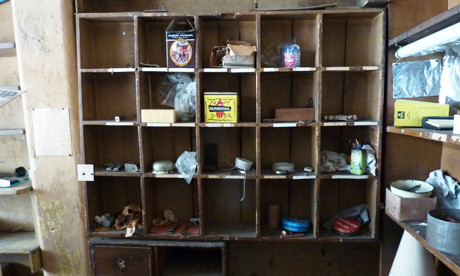Thems, Please
Local history need not merely be something absorbed through the pages of volumes stuffed with dates, names and other pedestrian facts. It lives and breathes in the world around us – in language, in bricks and mortar and in the infrastructure of our streets.
Artists sense this in their bones. Psychogeographers and ‘deep topographers’ wander around woozy with it, while in Folgate Street in the East End, Dennis Severs famously recreated the sights and smells of days of yore on different floors of a dillapidated house.
Closer to home, sculptor Des Hughes recently recreated the flavour of Victorian Hackney in an old newsagent, A.E. Barrow in Chatsworth Road.
In his new exhibition, Thems Please, which is on from now until August 7, he offers a glimpse into the interior and everyday life of a Victorian shop run by Mr Albert Robinson for at least 50 years.
The mish mash of items on show – treasure chests of foxed books, old Evening Standard headline boards, bus timetables, Players cigarette packets, tin boxes of jean button studs and other detritus – seem pregnant with thousands of memories and indicative of an endearing obsessiveness common among chroniclers of London.
The publicity material states that, although not made for the specifically for A. E. Barrow, Hughes’s work has “numerous parallels with its remaining contents with little details left here and there, Mr Robinson’s bendy pipe cleaner men found posing on his kitchen mantelpiece, the old half smoked cigar on the counter, layers of pricing stickers protruding from a shelf edge…”
Sculptures integrated into this physical collage provide “a surreal and often comic commentary on the monotony of the everyday”.
There has always been a huge market for this kind of eccentric nostalgia, but now more than ever people seem desperate learn about Hackney’s past. Like saints’ relics in a cathedral, Hughes’s objects seem to speak to this desire.
Thems Please is at 76 Chatsworth Road, E5 until 7 August and is open from Thursday-Sunday.
There will be workshops available for the children of Rushmore School, and the work they make will be exhibited in the window of the shop.
The exhibition is accompanied by a publication containing an essay by Shawn Lonergan and a history of A. E. Barrow.

